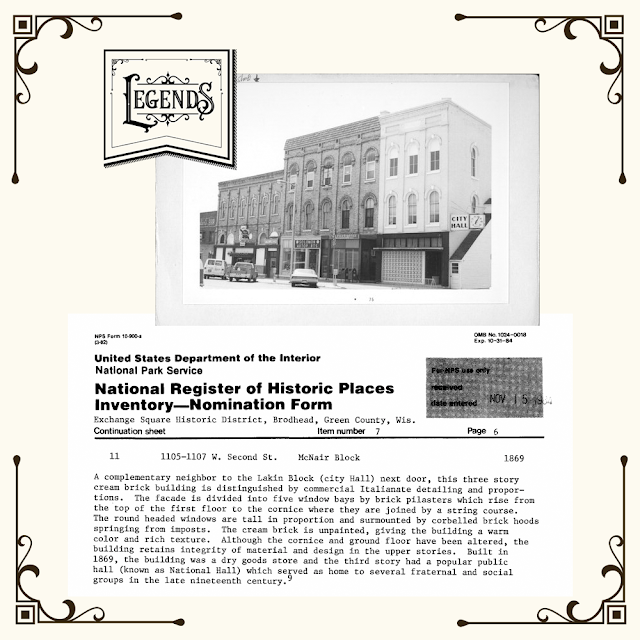Historic McNair Block
Built 1868
Architectural Style: Italianate
National Register Listing Date: November 15, 1984
State Register Listing Date: January 1, 1989
The McNair Block (1103-1111 W 2nd Ave.) is on the National Register of Historical Places. In research, it is difficult to understand if it is named after John L. McNair, or Miles. There is little digital footprint on Mile's genealogy. He and his family (wife Elizabeth & their children) are not part of the greater McNair family tree that is in this area of Green County, as their lineage seems to part over 100 years prior to Mile's birth.
However, I wanted to make a spot on this blog as a point of research, in hopes I can trace Mile's connecting to the McNair Block considering he was a business owner and elected official in Brodhead during the time of building this historic landmark.
I have a call out to the State Historical Society, Division of Historic Preservation to review correspondence, newspaper clippings, and historical information that is of public record, and will post an update upon compiling further research.
Notes about the McNair Block
via the State Historical Society
Notes about the Exchange Square Historic District
The McNair Block is part of the exchange Square Historic District, the following via the National Register of Historic Places gives more insight on the building and its importance.
"The development of the Exchange Square Historic District signalled more than the emergence of a regional commercial center. It also transformed the area from a primitive strip of shops into a mature community center, home to the opera houses, the fraternal lodges, and the public halls that provided education and entertainment
for Brodhead residents in an era before radio, television, or rapid transportation.
The transformation, however, was not sudden. As late as 1866 the newspaper lamented that Brodhead needed 'a public park or square and a town hall.' And in 1867, C. N. Carpenter attempted to form a joint stock company to construct a public hall.
Although Carpenter's plan never materialized, within a year of his plea Brodhead had one new hall--the Monell Block)--shortly followed by the halls in the Lakin Block, the Gombar Hall, the McNair Block, and the Broughton. Suddenly, the community had ample space to convene meetings, balls, political rallies, and church events. Nor was there a shortage of groups to use the facilities. In the late nineteenth century, Brodhead had a proliferation of social and fraternal organizations, including the Masons, the Patrons of Husbandry, the Odd Fellows, the Sons of Temperance, the GAR, The Womans Relief Corp, the Knights of Phythias, and others, meeting in any one of the available downtown halls.
In addition to meetings and rallies, the halls provided space for entertainments of the day, both home-grown and professional. Local bands, musical groups, and church choirs often performed from the .buildings, , More elaborate facilities were available at Gombars Hall (later Laube Hall, and then Manager Opera House, no. 3), which provided seats for 500 and movable scenery. The Broughton Opera House could seat 700(and make room for 1000 if needed) and featured a variety of touring vaudeville shows."
The transformation, however, was not sudden. As late as 1866 the newspaper lamented that Brodhead needed 'a public park or square and a town hall.' And in 1867, C. N. Carpenter attempted to form a joint stock company to construct a public hall.
Although Carpenter's plan never materialized, within a year of his plea Brodhead had one new hall--the Monell Block)--shortly followed by the halls in the Lakin Block, the Gombar Hall, the McNair Block, and the Broughton. Suddenly, the community had ample space to convene meetings, balls, political rallies, and church events. Nor was there a shortage of groups to use the facilities. In the late nineteenth century, Brodhead had a proliferation of social and fraternal organizations, including the Masons, the Patrons of Husbandry, the Odd Fellows, the Sons of Temperance, the GAR, The Womans Relief Corp, the Knights of Phythias, and others, meeting in any one of the available downtown halls.
In addition to meetings and rallies, the halls provided space for entertainments of the day, both home-grown and professional. Local bands, musical groups, and church choirs often performed from the .buildings, , More elaborate facilities were available at Gombars Hall (later Laube Hall, and then Manager Opera House, no. 3), which provided seats for 500 and movable scenery. The Broughton Opera House could seat 700(and make room for 1000 if needed) and featured a variety of touring vaudeville shows."

Photo Credits & Sources
(top to bottom)
- Wisconsin Historical Society
- Screen Grab from the National Register of Historic Places
*as Lap of Legends documents ongoing research, please utilize the post "tags" for the most recent and accurate information

